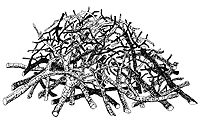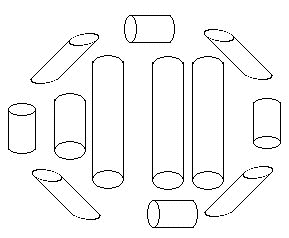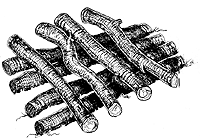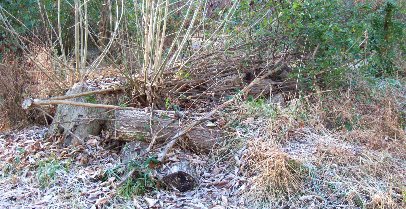|
BUILDING BETTER BRUSH PILES - Part 1 by Dr. Bruce Gabrielson There are probably as many different designs for brush piles as there are Beaglers who build them. There are also probably many people who build piles with no attempt at design at all. For a brush pile to work, they should be designed to provide good cover for rabbits while at the same time allow for the ability to quickly flush rabbits, provide internal ventilation and be easy to maintain. Certainly this is a goal that many rabbit habitat builders attempt to reach. This article deals with one of the brush piles that has become the most popular design in my starting pen so far as rabbits are concerned. It is also one that meets the other goals of a good design. Besides those connected to rabbit dens, I have three different designs that I personally maintain for the rabbits in my starting pen. This design is the largest takes the most time to create, but it also is the most likely place where I can flush older rabbits, plus it seems to be a magnet for small rabbits once they leave their den. I call this design the "Fort" since my kids liked to use it as a fort in the fall when they were younger.
Depicted in Figure 1, the design consists of a rough circular shape about 15 feet in diameter. The outer circle consists of cut logs and larger branches, many of which at one time formed the main part of the cover. During the early winter before we get a heavy snowfall, I evaluate my brush piles that need re-building. When a pile is to be rebuilt, the old branches are cleared to become part of the outer circle. Notice the shorter logs arranged with an opening to the circle at one end. This is the permanent human entry way to the internal of the pile. The space between the logs is left open until the brush pile is complete, then another log is place across this entry point. Figure 2 shows another simple pile design ready to be re-built. You first need to clear out all the old inner brush and move it to the outer edge of the logs that can't be re-used. The inner brush is easy to clear after a year or so of breaking down. If longer branches were used across the top in the initial construction, clearing takes very little time. A piece of tarp can be used over the entire foundation that will be explained later.
Raw Material Where do my branches come from and how can I continue to get them? Shown in Figure 3 is the primary source branches for all my brush piles. In this area we have lots of trees that keep on growing after you cut them down. What you see is a stump that was cut about 1 ½ foot above the ground. A year of growth (or longer if needed) represents the many branches that are shown. These branches represent a continuing resource that can be harvested whenever I need to re-build one of my piles. Notice also the rabbit feeder in the background and the log pile (and hidden burrow) at the branch base. A later article will discuss feeders and some of the designs that work best. If you don't have access to branches easily, I suggest you cut a small tree down to renew your brush piles each year and then use its branches. I've seen a few beagle clubs around that have very few trees left and need to rely on an annual Christmas tree gathering to keep their brush piles up. Christmas trees are very good thick sources of cover for piles, and can usually be obtained in quantity for free right after Christmas.
Once the inner circle is cleared, I create a basic lattice of cut logs and either branches or boards. I use logs that are about 10" to 12" in diameter for the support structure. The logs are arranged with about 9" to 10" of space between each end, and about 2 ½ feet spacing across. This design provides several access/escape points, plus allows the bottom of my pile plenty of air space. Between the logs I place the branches or boards. I prefer 2" x 4" boards since I can use treated lumber and they are flat. These boards become the support framework for both the top branches, and for either plywood covers and/or for small sheets of plastic tarp. I think a combination of both works best. I also often use a piece of plywood over the rear section of the pile since it holds up better with lots of rain and the weight of heavy snows. We seldom get a heavy snow storm here but I like to be safe. Branch Covering When the internal structure is complete, start covering with longer branches by placing them across the board lattice and parallel to the underlying logs. You should be able to put quite a few branches on the pile before it starts to get too high to easily throw them on. At this point, the pile is still too thin and you need to condense and weight it down. When this happens, throw a couple of heavier branches or thinner logs across the pile perpendicular to the under branches. This will weight down the first layer to form a heavier under layer. If the under layer is thick enough, you should be just able to still see the bottom tarp. If much of the tarp (or plywood) is exposed, keep going with another under layer followed by a second perpendicular log Shown in Figure 4 is a drawing of the final structure. When completed, the pile should be about 5 feet high, and you should not be able to make out any of the internal tarp or canvas covers. Notice in the figure that there is a cross log placed perpendicular to the under branches. The pile started to get too high (and thin) plus I could still see some of the inner structure so the additional layer was required. 
The final part of the construction process is to place a short log into the human entrance way into the circle. This log is not only useful while building the structure, but it becomes very useful after exceptionally heave snow storms for providing easy access and escape routs for rabbits. If the entrance gets too full of snow you can a square nose shovel to clean up the pathway. After often taking a walk in my pen to check rabbit activity during snowfalls, I've noticed that it usually takes quite awhile for my rabbits to dig themselves out of the brush piles. I'm really not sure if this delay in moving is because they wait until the storm is completely over, or that it just takes some time to get free. One time I removed my entry log right after a storm and noticed that there were immediately rabbits and many tracks to my feeders using this entryway. Maybe it's just that an easy access helps the rabbits to decide on moving sooner. Also, I did discover one interesting note about foxes after a snow. The first time when I opened up the entryway I noticed fox tracks all over the place near it. This was well before my starting pen fence was high enough to keep them from climbing and I also didn't have a fence charger to keep them out. Early in the day after I opened the entryway, I sat in an old deer tree stand about 20 yards from the bush pile and waited. I was pleasantly surprised to get a fox in about 30 minutes. Now I haven't had any foxes in my pen recently and am mostly concerned about providing access to feed for my rabbits during the heavy snows. However, this might be a consideration when removing the log if you're in a heavy fox area, or maybe if you want to create a place to draw in a sly fox. |
 Basic Design
Basic Design
